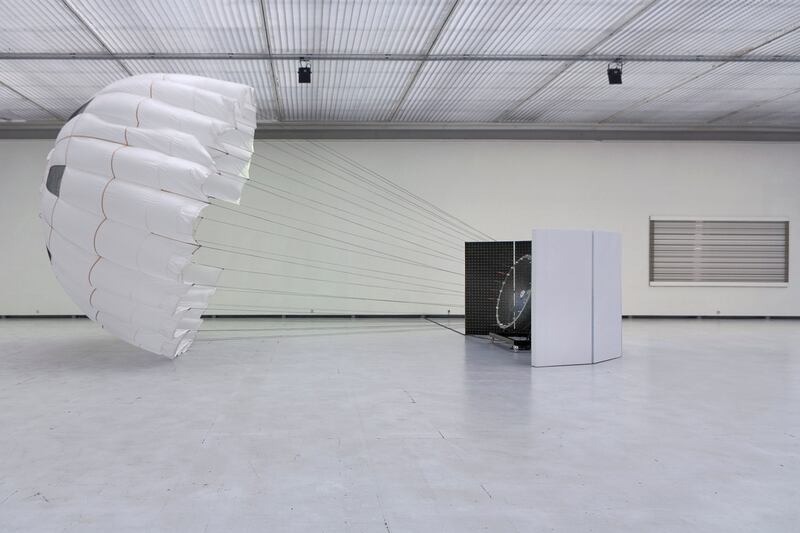In photographs taken from a distance, the works of German artist Carsten Nicolai look cold, calculated, and removed. Here you see a ghost-white parachute, about 13 feet across, too small to be used for skydiving. (“You’d just drop,” Nicolai says, clapping his right hand straight down on his left.) It rises up off the ground like a bulbous bat signal, tethered to a big wind machine that’s custom-made with shiny blue propellers from a real airplane.
But go in person and see Nicolai’s pionier i at Pace Gallery in New York (the exhibit opened Friday), and you might actually find the parachute collapsed on the ground, like a slain animal. Stick around long enough and you’ll be startled by the wheezing sound of the big fan as it suddenly turns on and shoots the chute up into the air, where it comes alive and lunges like a giant jellyfish. And then it lays down and dies again. I envision the ultimate realization of pionier i to be a silent video of it, cutting out the leaf-blowing sound of the fan. The dance is beautiful.
“But beauty is not necessarily what you want to achieve,” says Nicolai, dressed in a blue workman’s outfit (that Mexicans wear, he says) while he puts his installation together at Pace. He’s not concerned merely with what looks good. He wants to express something huge and complicated by very simple means.

“Mathematicians discover a formula to describe something very complex. A formula is a little bit easy to read. If it’s long, it’s not a beautiful formula. If they find one to describe something incredibly complex, and the formula is really short. Then they say, wow, it’s really beautiful.”
What Nicolai is interested in is time and movement, both of which are present in so much of his art. His pionier ii is three gently shifting and floating balloons mounted in the Piazza Plebiscito in Naples, Italy. The gorgeous rota looks like an alien lighthouse, with silvery lights spinning out of its core. Nicolai might even be better known as sound artist Alva Noto, and has dee-jayed and remixed pulsing electronic works by Ryuichi Sakamoto and Björk that listeners can bounce to.
But once you actually see his parachute move, how much strangeness is there? Nicolai said that his favorite artists are Buckminster Fuller and Nicola Tesla—an engineer and a scientist—whose works are nearly synonymous with mathematics. His favorite philosophical text is Wittgenstein’s Tractatus, that spectacular conversion of language into the mathematics of logical atomism. When rationality and reality can do much of the work for you, how involved will you be in arrogating art’s sensibilities and gradations?
Go to the Museum of Modern Art and stare at the Rothkos. The preferred distance to stand from them is 12 inches, as the painter suggested. From that spot, the canvas pulsates before your eyes, like a fabric reaching out to muffle you—like a primordial soup, bubbling.
Rothko, of course, is paint on a canvas. It is still. But it moves more mysteriously than Nicolai’s little formulas. Along with that wind that’s being blown at the parachute, there’s a lot of hot air.






